ALB signs and symptoms
Signs
 Adult Asian longhorned beetles (Anoplophora glabripennis) are 3/4 to 1-1/2 inches long, shiny black with white spots. The antennae are long and have alternating bands of black and white. The antennae are usually one to two times greater than the length of the body. The upper sections of the legs are whitish to blue. Adults are active from summer to mid-fall. (Photo by M. O'Donnell and A. Cline, California Department of Food and Agriculture, bugwood.org.)
Adult Asian longhorned beetles (Anoplophora glabripennis) are 3/4 to 1-1/2 inches long, shiny black with white spots. The antennae are long and have alternating bands of black and white. The antennae are usually one to two times greater than the length of the body. The upper sections of the legs are whitish to blue. Adults are active from summer to mid-fall. (Photo by M. O'Donnell and A. Cline, California Department of Food and Agriculture, bugwood.org.)
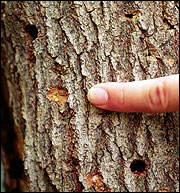 Females chew crater-shaped pits 1/2 inch in diameter into bark to deposit their eggs. The hole might appear orange. (Photo by Dennis Haugen, USDA Forest Service, bugwood.org.)
Females chew crater-shaped pits 1/2 inch in diameter into bark to deposit their eggs. The hole might appear orange. (Photo by Dennis Haugen, USDA Forest Service, bugwood.org.)
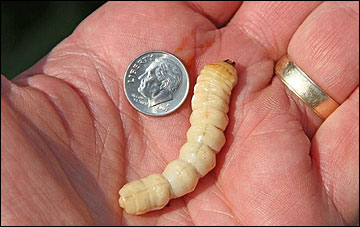 The wormlike larvae can be up to 2 inches long, are yellowish-white, cylindrical and fleshy, with a varied texture on the underside. Larval feeding galleries or tunneling might be visible on severely impacted trees. (Photo by Joe Boggs, affiliation unknown, bugwood.org.)
The wormlike larvae can be up to 2 inches long, are yellowish-white, cylindrical and fleshy, with a varied texture on the underside. Larval feeding galleries or tunneling might be visible on severely impacted trees. (Photo by Joe Boggs, affiliation unknown, bugwood.org.)
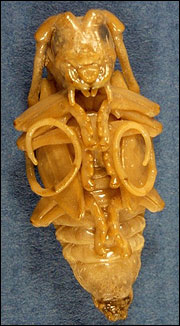 The pupae are generally 1 to 1-1/4 inches long and 1/2 inch wide, are off-white to light brown and appear like an immature version of the adult with legs and antennae compressed against the body. It takes three years for the ALB to mature. (Photo by Michael Borne, bugwood.org.)
The pupae are generally 1 to 1-1/4 inches long and 1/2 inch wide, are off-white to light brown and appear like an immature version of the adult with legs and antennae compressed against the body. It takes three years for the ALB to mature. (Photo by Michael Borne, bugwood.org.)
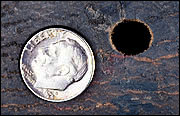 When the adult beetles emerge, they leave behind a hole 3/8 inch in diameter. (Photo by Daniel Herms, Ohio State University, bugwood.org.)
When the adult beetles emerge, they leave behind a hole 3/8 inch in diameter. (Photo by Daniel Herms, Ohio State University, bugwood.org.)
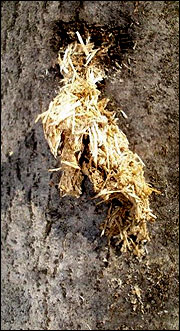 Wood shavings might be found extruding from holes in the bark and around the base of infested trees. (Photo by Kenneth R. Law, USDA APHIS PPQ, bugwood.org.)
Wood shavings might be found extruding from holes in the bark and around the base of infested trees. (Photo by Kenneth R. Law, USDA APHIS PPQ, bugwood.org.)
Do not confuse ALB with the cottonwood borer

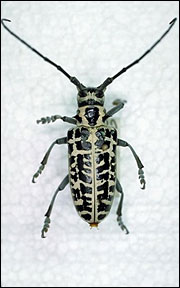 The Asian longhorned beetle (left) should not be confused with the cottonwood borer (right), a native longhorned beetle. The adult cottonwood borer has a more even mix of black and white patterns on its body and has solid black antennae. (Photo by M. O'Donnell and A. Cline, California Department of Food and Agriculture, bugwood.org and Robert J. Bauernfeind, Kansas State University, bugwood.org.)
The Asian longhorned beetle (left) should not be confused with the cottonwood borer (right), a native longhorned beetle. The adult cottonwood borer has a more even mix of black and white patterns on its body and has solid black antennae. (Photo by M. O'Donnell and A. Cline, California Department of Food and Agriculture, bugwood.org and Robert J. Bauernfeind, Kansas State University, bugwood.org.)